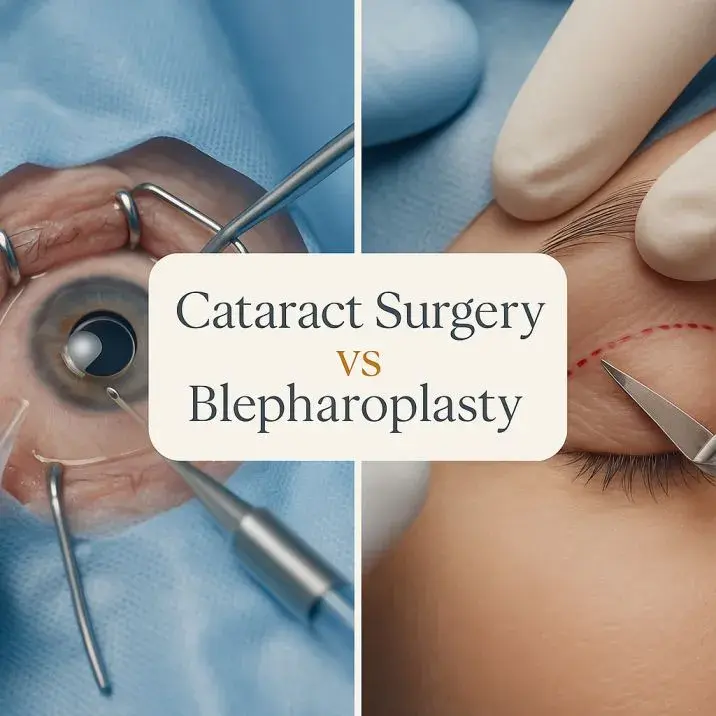How to get cosmetic eyelid surgery on the NHS
- Eyes Defined

- Jan 15, 2021
- 4 min read
Updated: Dec 25, 2024
Eyelid surgery can significantly impact quality of life, but accessing it through the NHS comes with strict criteria. Here, we explore the procedures available and their qualifications.
Eyelid Surgery on the NHS: What’s Available?
Upper Eyelid Surgery (Blepharoplasty)
Upper eyelid blepharoplasty is occasionally performed on the NHS but only for functional reasons. If drooping upper eyelids obstruct vision or impair daily activities, surgery may be approved.
Lower Eyelid Surgery
Lower eyelid surgery, including blepharoplasty for cosmetic concerns like eye bags, is rarely offered on the NHS. However, specific conditions such as cicatricial ectropion may qualify.

NHS Criteria for Eyelid Surgery
The NHS enforces strict guidelines to determine eligibility for eyelid surgery. These include:
Visual Field Tests: Conducted to prove that droopy eyelids obstruct vision.
Photographic Evidence: Taken by the hospital to confirm the severity of the issue.
Impact on Quality of Life: Demonstrated evidence that the condition affects daily living.
These requirements ensure surgeries are performed only for medical necessity, not cosmetic enhancement.
Medical Conditions That Qualify for Surgery
Cicatricial Ectropion
This condition involves the outward turning of the lower eyelid due to skin tightening. The procedure often uses excess skin from the upper eyelid to correct the issue, with scars typically hidden beneath the lashes.
Thyroid Eye Disease
Patients with thyroid eye disease may experience disfigurement during the “burnt-out phase.” Surgeries may include:
Blepharoplasty: To improve appearance.
Orbital Decompression: To alleviate pressure.
Squint Surgery: To correct double vision.
Reconstruction Post-Skin Cancer
Eyelid reconstruction may follow the removal of cancer from the upper or lower lids. Surgeons may use excess skin from a blepharoplasty to aid in reconstruction, ensuring functionality and appearance are restored.
Risks and Recovery from Eyelid Surgery
Like all surgeries, eyelid procedures come with risks. These may include:
Common Side Effects: Swelling, dry or watery eyes, and blurry vision during recovery.
Rare Complications: Permanent dry eye, double vision, or, in extremely rare cases, vision loss.
Tips for Recovery
Use a cold compress to reduce swelling.
Sleep with your head elevated.
Follow post-operative care instructions closely.
Always discuss potential risks and aftercare with your surgeon during the initial consultation.
The Role of Oculoplastic Surgeons
Most NHS eyelid surgeries are performed by oculoplastic surgeons, specialists in medical and functional eyelid procedures. Unlike cosmetic surgeons, their focus is on addressing medical conditions rather than aesthetics.
Article Summary
Eyelid Surgery Options: Blepharoplasty and ptosis correction are available on the NHS but only for medical, not cosmetic, reasons.
Strict NHS Criteria: Surgery is considered only when vision or quality of life is severely affected.
Medical Conditions Covered: Includes cicatricial ectropion, thyroid eye disease, and reconstruction post-skin cancer.
Risks and Recovery: Swelling, dry eyes, and rare complications like double vision are possible.
FAQs About Eyelid Surgery on the NHS
Who Performs NHS Eyelid Surgery?
These surgeries are typically performed by oculoplastic surgeons who specialize in eyelid and orbital procedures.
What Conditions Typically Qualify?
Conditions like cicatricial ectropion, thyroid eye disease, and eyelid reconstruction post-skin cancer often qualify for NHS coverage.
Is Eyelid Surgery Painful?
The procedure is usually done under local or general anesthesia, so discomfort during surgery is minimal. Some soreness or swelling during recovery is normal.
How Long Is the Recovery Period?
Most people recover within 2-4 weeks, but full healing may take longer. Patients are advised to follow post-surgical care instructions closely.
What Are the Risks of Eyelid Surgery?
Common risks include swelling, dry eyes, and blurry vision. Rare complications include permanent dry eye, double vision, or vision loss.
Can Children Get Eyelid Surgery on the NHS?
Children may qualify if a condition like ptosis significantly affects their vision or daily life. Parental consent and consultation with specialists are required.
What Is the Cost of Private Eyelid Surgery?
Private eyelid surgery costs vary but typically range from £2,000 to £5,000, depending on the complexity and provider. This option is available for cosmetic concerns.
Are There Alternatives to Surgery?
Non-surgical options like dermal fillers or laser treatments can address minor cosmetic concerns but are not covered by the NHS.
What Documentation Is Required for NHS Approval?
The NHS requires photographic evidence and visual field tests to confirm that eyelids impair vision or significantly affect quality of life.
How Can I Prepare for Surgery?
Patients should avoid smoking, follow pre-operative guidelines, and discuss all medications with their surgeon to ensure a smooth procedure and recovery. Private eyelid surgery costs vary but typically range from £2,000 to £5,000, depending on the complexity and provider. This option is available for cosmetic concerns.
Are There Alternatives to Surgery?
Non-surgical options like dermal fillers or laser treatments can address minor cosmetic concerns but are not covered by the NHS.
What Documentation Is Required for NHS Approval?
The NHS requires photographic evidence and visual field tests to confirm that eyelids impair vision or significantly affect quality of life.
How Can I Prepare for Surgery?
Patients should avoid smoking, follow pre-operative guidelines, and discuss all medications with their surgeon to ensure a smooth procedure and recovery.
Latest Trends: Cosmetic Alternatives to Eyelid Surgery
For those who don’t qualify for NHS surgery, modern cosmetic treatments such as laser resurfacing and dermal fillers offer non-invasive options for addressing droopy eyelids and eye bags.
If you’re considering eyelid surgery, consult an oculoplastic specialist to discuss your options. Whether through the NHS or private care, understanding your eligibility and the procedure’s benefits is essential. Share this post to help others understand their options for eyelid surgery. Additionally, explore our related articles for more insights and guidance on similar procedures.




Comments